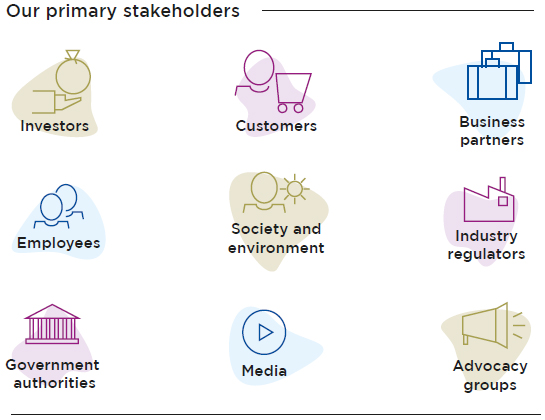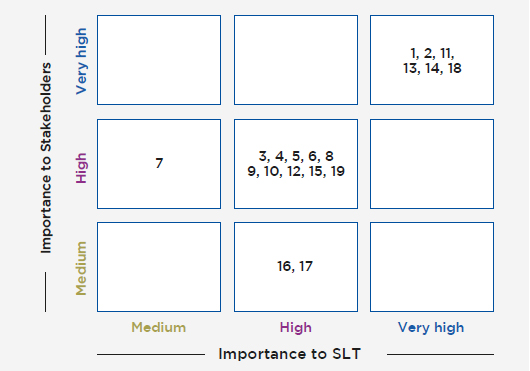Business Model
Stakeholders
The individuals and organisations that are impacted by SLT’s activities, products, and services constitute our stakeholders. Conversely, these stakeholders can have an impact on how SLT implements its strategies and achieves its objectives.
SLT’s key stakeholders include its shareholders, customers, business partners, employees, Government authorities, industry regulators, media and advocacy groups, and the communities and environment the Company operates in. SLT strives to better understand its stakeholders through various means of engagement and accordingly optimises its strategies, products, and services to deliver mutually beneficial outcomes for all parties.

Identification and engagement
The operations of the SLT Group have an impact on the lives of all Sri Lankans. The varying interests amongst various stakeholder groups can sometimes conflict with each other; therefore, the identification and prioritisation of SLT’s stakeholders is essential to understanding and meeting short-term needs and long-term expectations.
SLT systematically approaches stakeholder mapping after analysing the operating environment and the ideal strategies for addressing opportunities and threats within the environment. This shapes the engagement processes that SLT pursues with its stakeholders and has led to the establishment of various engagement platforms. Through these platforms, SLT seeks to understand the views of its stakeholders and communicate with them, addressing any concerns that they may have.
|
Material issues pertaining to the stakeholder |
Engagement |
Frequency of engagement |
Key initiatives for the year |
Investors |
|||
|
Dividend, share price, innovation and industry growth |
|
|
AGM and rating reviews to rating agencies |
|
|
||
|
|
||
|
|
||
|
|
||
|
|
||
Customers |
|||
| Improve customer relationship and retention |
|
|
Annual Brand Health Track Study Regional Account Management Customer gatherings |
|
|
||
|
|
||
|
|
||
|
|
||
|
|
||
|
|
||
|
Improve SME customer relationship and retention |
|
|
SME forums Field sales campaigns |
|
|
||
|
|
||
|
|
||
|
|
||
|
|
||
|
|
||
|
Improve enterprise customer relationship and retention |
|
|
Enterprise forums |
|
|
||
|
|
||
|
|
||
Business partners |
|||
|
Better return, innovation and industry growth |
|
|
|
|
|
||
|
|
||
|
Dealers looking for strengthening brand presence and improving sales |
|
|
Dealer convention |
|
|
||
|
|
||
|
|
||
|
|
||
| Suppliers looking for better return, innovation and industry growth |
|
|
Publications Awareness on new business strategy and culture |
|
|
||
|
|
||
|
|
||
|
|
||
Employees |
|||
| Employee welfare, satisfaction, retention, training and development |
|
|
|
|
|
||
|
|
||
|
|
||
|
|
||
|
|
||
|
|
||
|
|
||
|
|
||
|
|
||
|
|
||
Government and regulatory authorities |
|||
|
Investment and infrastructure development, better return, innovation and industry growth, compliances and digital services or smart Sri Lanka services |
|
|
Monthly meetings with the regulator forums |
|
|
||
|
|
||
|
|
||
Community (society and the environment at large) |
|||
| Community investment and infrastructure development |
|
|
|
|
|
||
|
|
||
|
|
||
|
|
||
External initiatives
SLT is in alliance with several association and has its' staff actively participating in events and activities to strengthen such collaborations.
National
- National Broadband Committee
- National Chamber of Commerce
- Next Generation Network Committee
- Government initiative of free Wi-Fi programme
- Online secondary school education (SchoolNet) programme
- Online university education programme (LEARN) programme
- eGovernment programme
- Sri Lanka Internet Society
International
- SEA-ME-WE connectivity consortium
- IPv6 Execution Committee
- Global Internet Exchange Network
- International PoP Community
- Commonwealth Telecommunications Organisation (CTO)
- International Telecommunication Union (ITU)
- Fibre-to-the-Home Community
- Carrier Ethernet Forum
- Carrier Grade Wi-Fi Forum
- International Internet Society
- MEF – Metro Ethernet Forum
- IEEE – Institute of Electrical and Electronics Engineers
- IET – The Institution of Engineering & Technology
- CECP – Carrier Ethernet Certified Professional
Materiality
SLT’s business model focuses on aspects that are important to the telecom business (SLT Group) and its stakeholders. “Importance” is judged by the relevance and significance of an aspect, as determined by the probability of occurrence and the magnitude of the impact.
The identification of these aspects is facilitated through effective engagement with SLT’s stakeholders. These aspects are listed below along with their importance to the business and its stakeholders.
| No. | Topic | Importance to SLT | Importance to stakeholder | |||
| 1. | Economic performance | Very high | Very high | |||
| 2. | Indirect economic impacts | Very high | Very high | |||
| 3. | Procurement practices | High | High | |||
| 4. | Anti-corruption | High | High | |||
| 5. | Anti-competitive behaviour | High | High | |||
| 6. | Energy | High | High | |||
| 7. | Biodiversity | Medium | High | |||
| 8. | Emissions | High | High | |||
| 9. | Effluents and waste | High | High | |||
| 10. | Environmental compliance | High | High | |||
| 11. | Employment | Very high | Very high | |||
| 12. | Occupational health and safety | High | High | |||
| 13. | Training and education | Very high | Very high | |||
| 14. | Diversity and equal opportunity | Very high | Very high | |||
| 15. | Freedom of association and collective bargaining | High | High | |||
| 16. | Local communities | High | Medium | |||
| 17. | Marketing and labelling | High | Medium | |||
| 18. | Customer privacy | Very high | Very high | |||
| 19. | Socioeconomic compliance | High | High |
Materiality matrix



